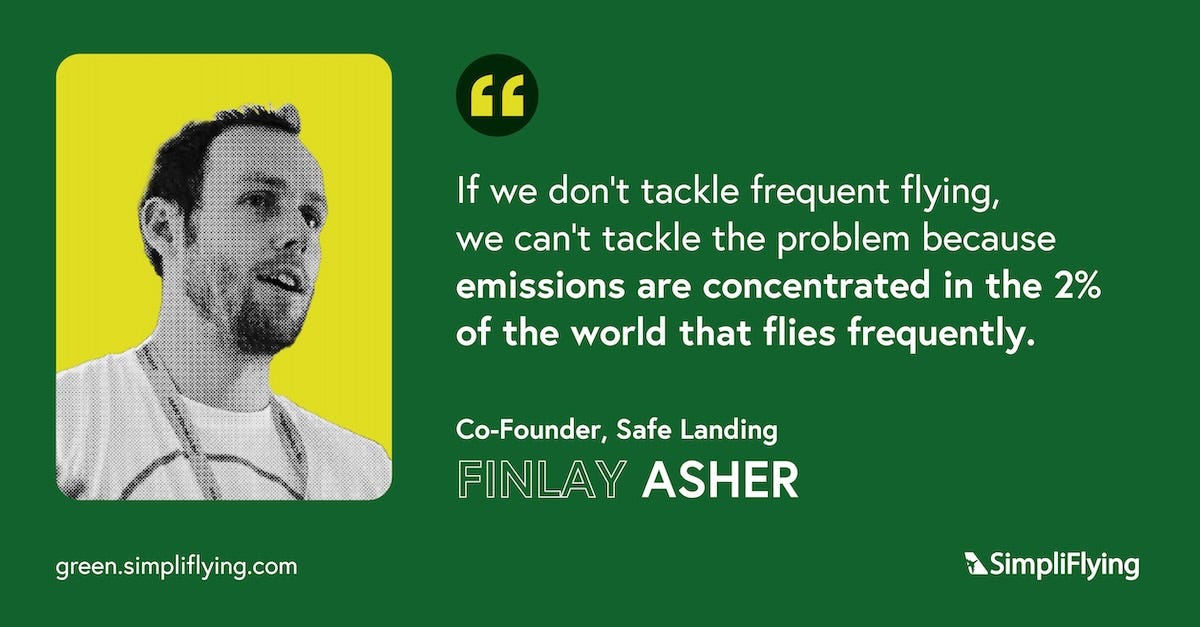In this episode of our ‘Sustainability in the Air’ podcast, Finlay Asher, co-founder of Safe Landing, speaks with SimpliFlying CEO Shashank Nigam. Safe Landing is a global community of aviation workers who are working within the sector to reduce the climate impact of aviation.
In 2019, with growing climate activism and the UK declaring a climate emergency, Asher felt that the industry’s emissions reduction plans were not feasible and could not be met. He started an employee sustainability group, organising lunchtime talks to discuss the challenges and gather like-minded colleagues.
When the COVID-19 pandemic hit in 2020, Asher decided to quit his job and pursue environmental campaigning full-time. He created YouTube videos about his experiences and connected with other concerned aviation workers, including pilots, cabin crew, and air traffic controllers. Together, they formed “Safe Landing,” a group advocating for faster sustainability progress in the industry and empowering workers to make a difference using their skills and knowledge.
Here are the key highlights of the conversation:
The need for a holistic approach to sustainable aviation (11:30)
Balancing growth and sustainability in aviation (16:30)
Equity and fairness in aviation decarbonisation (21:05)
The potential and limitations of Sustainable Aviation Fuels (SAF) (39:05)
Demand reduction and frequent flyer levies (52:09)
Alternative approaches and carbon removal (57:51)
Rapid Fire! (1:08:58)
Keep reading for a quick overview of the episode.
Why it’s important to stick to a carbon budget
The term carbon budget refers to the maximum cumulative net CO₂ emissions that may be produced annually, which would limit global warming to a certain temperature limit – usually 1.5°C above pre-industrial levels, as agreed in the Paris Agreement.
Asher argues that the aviation industry is currently ignoring this budget constraint under the mistaken assumption that emissions can continue to grow as long as net zero is achieved at some point in the future.
Climate activists believe aviation is depleting the carbon budget by delaying climate action. If business-as-usual continues, the industry will exhaust its carbon budget for 1.5°C warming within the next decade and risk losing the chance to limit warming to 2°C, says Asher. He emphasises the need for the industry to recognise and operate within the boundaries of the carbon budget to effectively combat the climate crisis.
“If we continue to doing what we’re doing today, emissions are going to continue to go up, or stay relatively stable over the next 10 years. And that’s with every assumption in there, of every efficiency improvement, every alternative fuel, and every alternative technology like electric or hydrogen. So it’s not that those things aren’t good, and that we shouldn’t be working on them... It’s just that we shouldn’t let pictures of those things distract us from the policies that we need today.”
5 takeaways from the conversation
1. Why policies and technology are complementary
Acknowledging the importance of efficiency improvements, Asher argues that such gains alone are not enough to tackle the growing emissions.
The efficiency improvements over the past 50 years are more than offset by the overall growth in the aviation industry. There has been an increase in the number of flights, energy use, and emissions – a clear illustration of Jevons paradox, he adds (i.e., efficiency improvements leading to increased consumption rather than the intended conservation).
He also critiques airlines for lobbying against carbon budgets, taxes, and other financial measures that could drive down emissions. Asher believes that policies and technological advancements are complementary in achieving emission reductions and creating jobs in the industry and that the absence of policies like higher carbon taxes hinders the acceleration of technological progress.
2. Why unconstrained growth may force drastic measures
Asher argues that unconstrained growth in aviation will lead to a significant industry crash in 10-15 years. Due to climate change, extreme weather events, heat waves, and rising sea levels will not only affect the industry directly but also disrupt economies and livelihoods, ultimately reducing demand for air travel.
Asher advocates for a planned, moderate approach to preserve the ability to fly sustainably in the future. He acknowledges the challenges of convincing individual airlines to limit growth due to competitive pressures, with each carrier fearing that their competitors will fill any capacity they leave unmet. Asher believes that government and regulatory intervention will be essential to enforce carbon budgets and curb the industry’s unrestrained growth.
“We’re in this kind of dog-eat-dog race to the bottom where we can’t sustain with the current system. And what we need in this scenario is [for the] government and regulators to step in and say, this is the budget that you have, and you can compete within that. But we can’t have unlimited unconstrained growth where we all suffer eventually.”
3. Why SAF may be a limited pathway to decarbonisation
Asher acknowledges that current SAF pathways, like waste oil biofuels, are limited due to feedstock constraints and can create perverse incentives, such as importing waste oils from distant locations or incentivising the production of virgin palm oil.
Asher also expresses concerns about the resource intensity of producing SAF at a large scale, particularly e-fuels derived from renewable electricity. He estimates that meeting just the UK’s jet fuel demand with e-fuels would require the equivalent of the country’s entire current electricity generation capacity or five times its current nuclear power capacity. Globally, the cost of building the necessary nuclear power infrastructure could reach $4 trillion, he adds.
Given these challenges, Asher proposes a more nuanced approach to SAF, gradually introducing them alongside efficiency improvements and demand reduction measures. He argues for a comprehensive, evidence-based analysis of SAF pathways to ensure resources are allocated effectively to maximise emissions reductions. This may involve prioritising the most promising SAF technologies and balancing their deployment with investments in other decarbonisation efforts, such as renewable energy for ground transportation and agriculture.
4. Why demand reduction may be necessary
Asher advocates for policies to reduce demand for aviation, particularly targeting frequent fliers who account for a disproportionate share of emissions. He cites studies showing that just 1-2% of the world’s population is responsible for a significant portion of aviation emissions due to frequent flying.
To address this, Asher proposes a frequent flyer levy, where the cost of flying increases progressively with each additional flight taken by an individual within a given time period. He argues that this would be a fair way to allocate the costs of decarbonisation, as those who fly the most and have the greatest financial means would bear a larger share of the burden.
Given their reliance on frequent flyer programs, airlines would also need to re-evaluate their business models and revenue strategies to align with the realities of a carbon-constrained world, Asher asserts.
5. Why employee activism matters
Asher believes that groups like Safe Landing empower people and offer a unique platform for sustainability advocacy. Within companies there are limited opportunities for championing such concerns, as employees may fear negative career consequences for expressing views that conflict with company strategy. As a result, this discourages them from speaking up even when the issues are critical to the industry’s safety and sustainability, he adds.
Safe Landing aims to amplify these voices and empower workers to push for change – both publicly and within their companies. The group provides a platform for those who have left the industry or are more confident in speaking out publicly to share their views, while also supporting and encouraging others to advocate for change internally.
‘Sustainability in the Air’ is the world’s leading podcast dedicated to sustainable aviation. Through in-depth conversations with top aviation leaders, we break through the clutter and provide a clear roadmap for a net-zero future.














